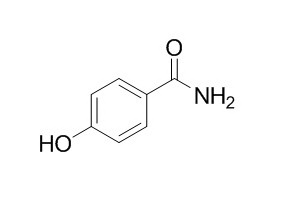4-Hydroxybenzamide
4-Hydroxybenzamide is a natural product from Berberis pruinosa.
Inquire / Order:
manager@chemfaces.com
Technical Inquiries:
service@chemfaces.com
Tel:
+86-27-84237783
Fax:
+86-27-84254680
Address:
1 Building, No. 83, CheCheng Rd., Wuhan Economic and Technological Development Zone, Wuhan, Hubei 430056, PRC
Providing storage is as stated on the product vial and the vial is kept tightly sealed, the product can be stored for up to
24 months(2-8C).
Wherever possible, you should prepare and use solutions on the same day. However, if you need to make up stock solutions in advance, we recommend that you store the solution as aliquots in tightly sealed vials at -20C. Generally, these will be useable for up to two weeks. Before use, and prior to opening the vial we recommend that you allow your product to equilibrate to room temperature for at least 1 hour.
Need more advice on solubility, usage and handling? Please email to: service@chemfaces.com
The packaging of the product may have turned upside down during transportation, resulting in the natural compounds adhering to the neck or cap of the vial. take the vial out of its packaging and gently shake to let the compounds fall to the bottom of the vial. for liquid products, centrifuge at 200-500 RPM to gather the liquid at the bottom of the vial. try to avoid loss or contamination during handling.
Int J Mol Sci.2022, 23(11):6104.
J Appl Microbiol.2022, 132(2):949-963.
Biomedicine & Pharmacotherapy2020, 125:109950
Biochem Biophys Res Commun.2018, 505(1):194-200
Journal of Phytopathology2021, 169,Issue11-12.
Journal of Ginseng Research2022, j.jgr.2022.09.005.
Pharmacognosy Magazine2018, 14(56):418-424
Phytomedicine.2016, 23(4):331-9
Phytother Res.2019, 33(4):1104-1113
Molecules.2019, 24(4):E744
Related and Featured Products
J Phys Chem B. 2015 Aug 20;119(33):10466-77.
Influence of Secondary Interactions on the Structure, Sublimation Thermodynamics, and Solubility of Salicylate:4-Hydroxybenzamide Cocrystals. Combined Experimental and Theoretical Study.[Pubmed:
26258951]
Cocrystal screening of 4-Hydroxybenzamide with a number of salicylates (salicylic acid, SA; 4-aminosalicylic acid, PASA; acetylsalicylic acid, ASA; and salicylsalicylic acid, SSA) was conducted to confirm the formation of two cocrystals, [SA+4-OHBZA] (1:1) and [PASA+4-OHBZA] (1:1).
METHODS AND RESULTS:
Their structures were determined using single-crystal X-ray diffraction, and the hydrogen-bond network topology was studied. Thermodynamic characteristics of salicylic acid cocrystal sublimation were obtained experimentally. It was proved that PASA cocrystallization with 4-OHBZA makes the drug more stable and prevents the irreversible process of decarboxylation of PASA resulting in formation of toxic 3-aminophenol. The pattern of non-covalent interactions in the cocrystals is described quantitatively using solid-state density functional theory followed by Bader analysis of the periodic electron density. It has been found that the total energy of secondary interactions between synthon atoms and the side hydroxyl group of the acid molecule in [SA+4-OHBZA] (1:1) and [PASA+4-OHBZA] (1:1) cocrystals is comparable to the energy of the primary acid-amide heterosynthon. The theoretical value of the sublimation enthalpy of [SA+4-OHBZA], 231 kJ/mol, agrees fairly well with the experimental one, 272 kJ/mol.
CONCLUSIONS:
The dissolution experiments with [SA+4-OHBZA] have proved that the relatively large cocrystal stability in relation to the stability of its components has a negative effect on the dissolution rate and equilibrium solubility. The [PASA+4-OHBZA] (1:1) cocrystal showed an enhancement of apparent solubility compared to that of the corresponding pure active pharmaceutical ingredient, while their intrinsic dissolution rates are comparable.



